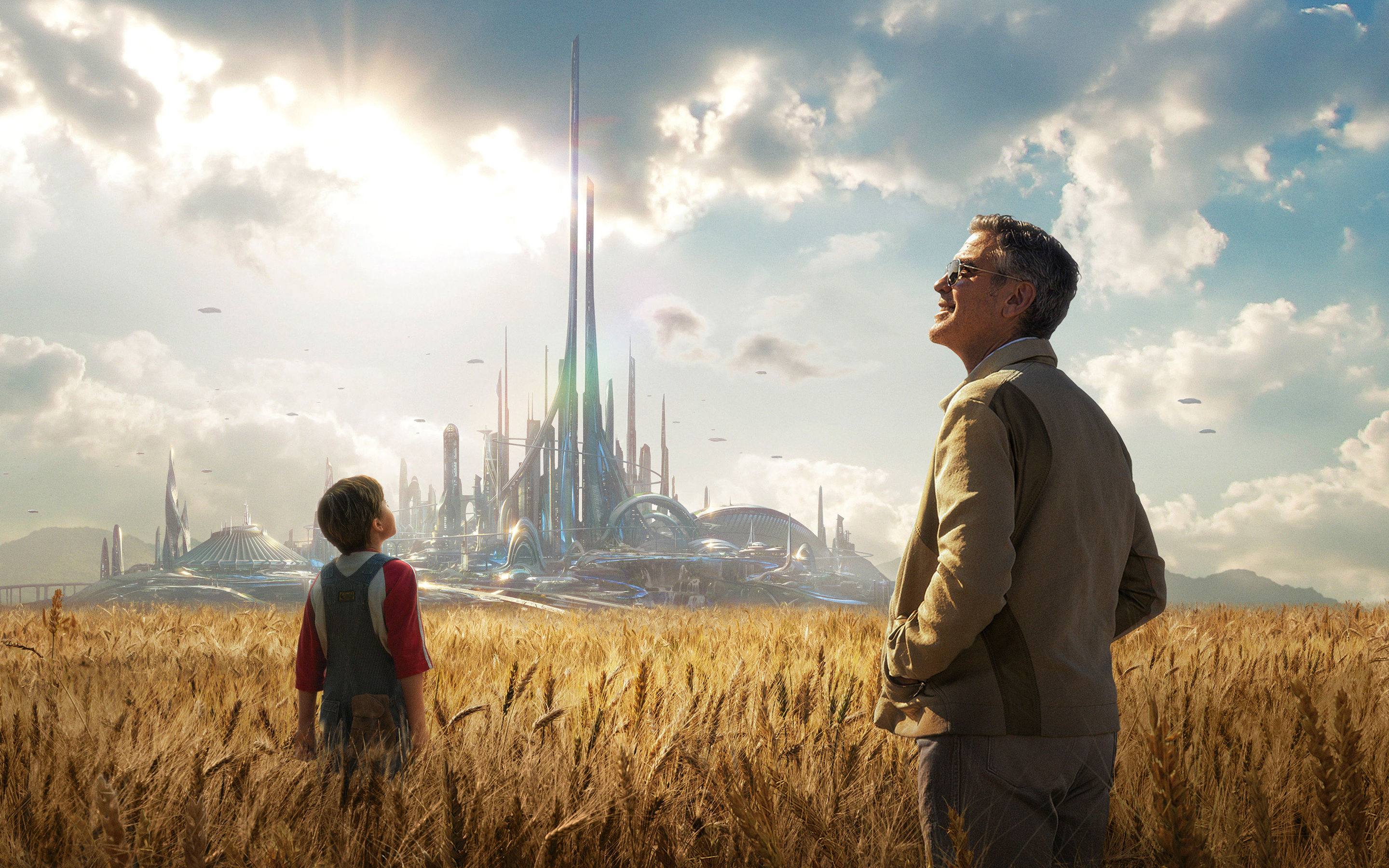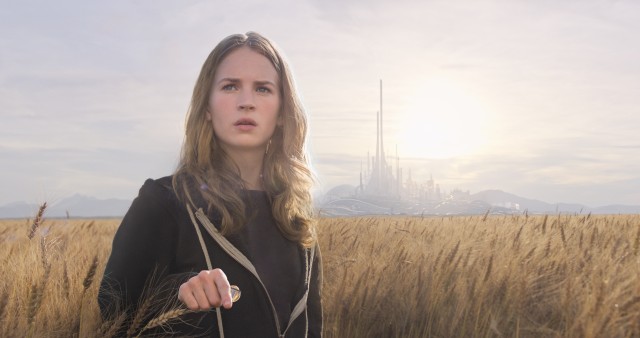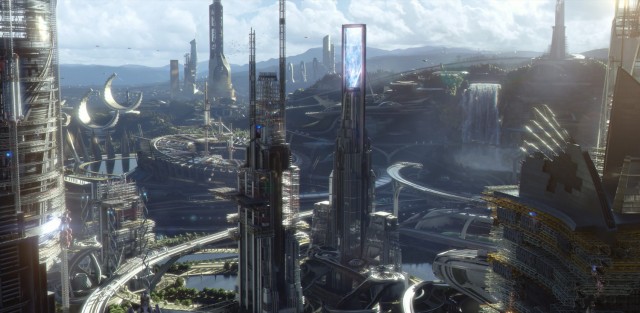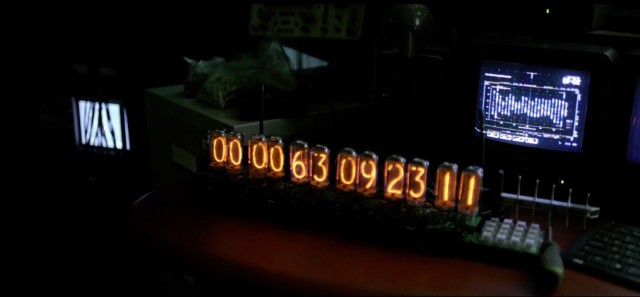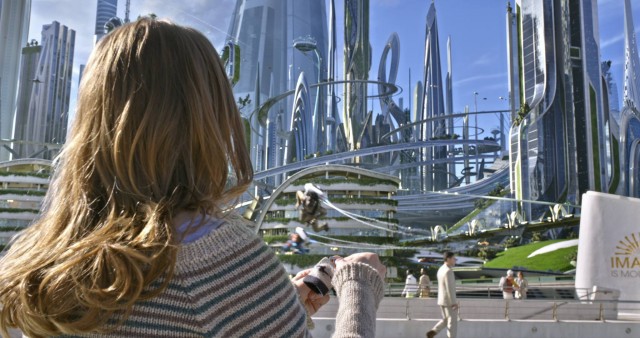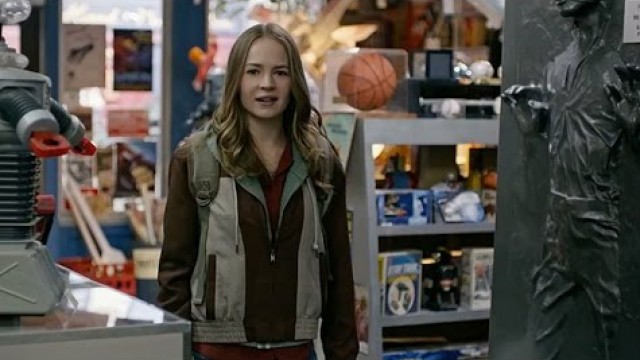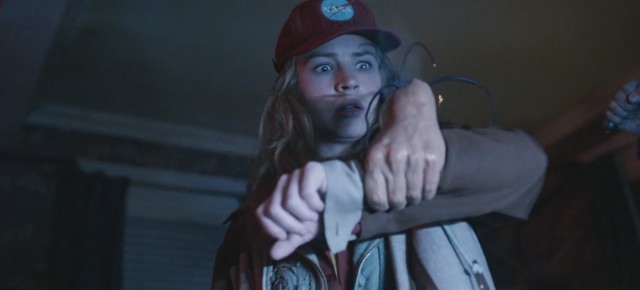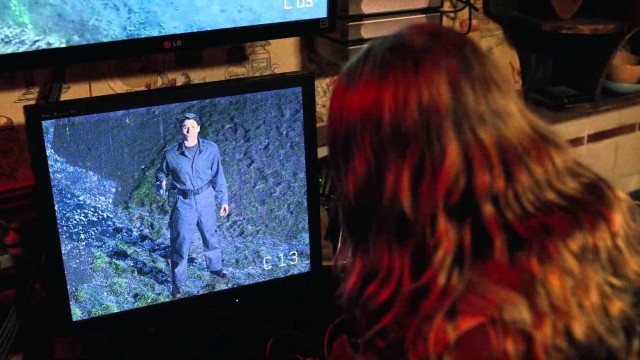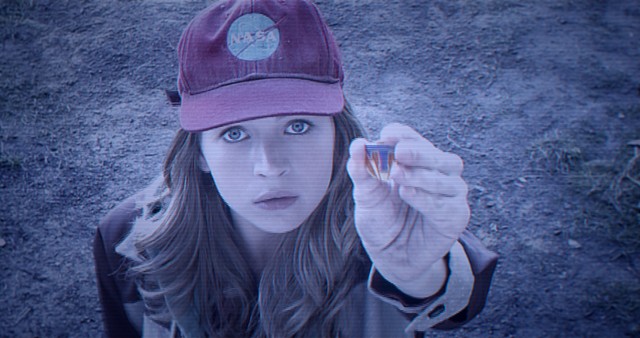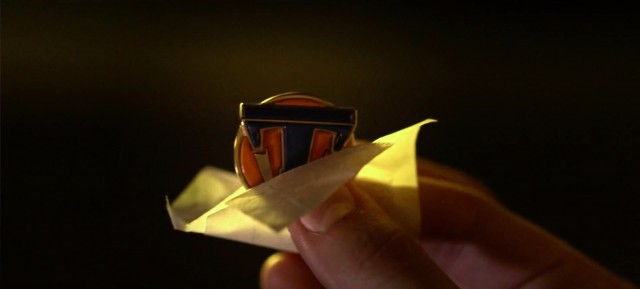Like a wide-eyed young idealist with big dreams, Disney’s big new blockbuster movie, Tomorrowland is a masterpiece of imagination and charm, one with a surprising amount of wisdom behind it… But it also forgot to iron out the glitches in its incredible invention.
Tomorrowland was originally announced under the working title of ‘1952‘, which is a bit strange, seeing as ‘Tomorrowland’, the Disney theme park attraction that inspired this movie, didn’t open until 1955. Presumably, it was meant to be a prequel to the inception of a real-life Tomorrowland, which the Disney theme parks were meant to demonstrate as an upbeat view of humanity’s future, but, naturally, you can see why Tomorrowland may not quite be relevant in this fear-driven age.
Still, the way that Tomorrowland takes the world’s modern fear economy on the nose, and finds itself delivering more timely themes than one would imagine, is certainly quite commendable. If nothing else, the movie will also delight viewers with its wonderful visual polish, making it very appealing to look at, even when the story is at its shakiest. This pretty presentation will no doubt be the biggest draw for young children, while adults can enjoy a story that, while uneven, has enough inspiration behind it to give the movie some surprising thematic power.
In fact, Tomorrowland, despite some of its frustrating flaws, is well worth seeing for the theme of looking ahead with hope, not despair. It’s a message that modern society no doubt needs to hear. With that said though, be sure to keep your expectations in check. Tomorrowland is good, but it’s certainly not Disney’s next big groundbreaker.
Tomorrowland stars Casey Newton, played by Britt Robertson, a teenage prodigy who finds herself on the path of mischief and vandalism, after butting heads with her father’s employer, NASA. Casey’s disregard for authority and stubborn desire to change the world is what gets her noticed by a world beyond our own, netting her a futuristic pin that allows her to see a special place whenever she touches it.
Naturally, Casey is obsessed with the mysterious place, and this puts her on the trail of the movie’s other lead, Frank Walker, played by George Clooney, an aged cynic who has retreated from society. Since these two begin the movie by telling their story, it’s inevitable that Casey will inspire Walker, and the two will have a great adventure, and, yeah, this is Disney. You know how this will go.
Tomorrowland also sports a third lead, a young girl named Athena, played by Raffey Cassidy. Athena is meant to be the connective tissue between these two unlikely heroes, and their enigmatic destination, and naturally, there’s more to her than meets the eye. I can’t talk too much about that though, since it would obviously constitute spoilers.
Tomorrowland’s characters are pretty straightforward for the most part, but this is another case where that sort of makes sense. The movie is driven by one singular vision, and while it’s valid to criticize said vision for being clearly ‘Disney-fied’, not really having as much teeth as this same story would if it came from a different studio, there’s still something beautiful about its simplicity. The narrative behind the personalities doesn’t waste time on unnecessary questions or development. Hell, at one point, Frank even outright says to Casey that she should just stop asking questions and be amazed. It almost seems like a demand that the movie is making of its audience as well!
Then again though, that only goes so far. One of the issues with Tomorrowland is the fact that it seems to set up this big cast of characters, but then it doesn’t do very much with most of them. Despite the fact that Casey’s father is played by Tim McGraw of all people, and her mother is played by Judy Greer for all of thirty seconds of flashback (why bother springing for Judy Greer then?), both of these characters exit the movie rather quickly, especially the mother. Likewise, there’s one fun bit where Kathryn Hahn and Keegan-Michael Key cameo as two eccentric shop owners who show up in Casey’s quest for directions, but they’re never seen past that moment, even if it is a pretty great moment. Again, what’s the point of springing for two successful comedy actors, if you’re barely going to make them a part of the story?
Arguably the worst issue with the characters though is Hugh Laurie’s character, David Nix. You can see the turn that this character is going to take right from the start of the movie, and yet despite that, there’s no believable buildup. This leaves Tomorrowland in the awkward situation of setting up a grand plan that incorporates this well-known actor as a key character behind this movie’s fantastical world, and then, by the time it gets there, any impact that this character could have had is gone. This is the largest reason why Tomorrowland’s finale is an unfortunate bust, with the big, sweeping buildup sadly leading nowhere surprising, or even interesting.
Still, there is merit, and at least some sense of wonder to the journey, and this leads to some of the futurist philosophies discussed by the characters succeeding where the rest of the story stumbles. The performances are also quite good as well, even if the actors could have better benefited with a script that doesn’t end up collapsing under its own weight by the end.
Still, if nothing else, the lead personalities are charming enough to take this journey with.
Tomorrowland is a movie with so much brilliant setup and imagination behind it. That’s why it’s frustrating when it fumbles some of that incredible potential by the weak payoff its third act.
Even before that though, the incredibly ambitious storyline of Tomorrowland is routinely let down by its very evident problems with pacing and structure. The movie has an odd setup that feels a bit disjointed, which may be intentional, given that Casey and Frank spend the first bit of the movie arguing about how to tell the story. It’s kind of a funny joke, but it might leave some audiences confused, if they can’t wrap their head around the recipe of a Disney blockbuster like this right away.
From there, Tomorrowland has a good chunk of solid storytelling and setup in its first two acts, though again, the pacing can still be an issue here. The movie’s placement of action scenes feels a bit awkward, and it sometimes creates this sense of stop/start pacing that has more action-packed bits sometimes appearing at pure random, after long stretches of slow, introspective dialogue, before going back to said slow, introspective dialogue immediately after. There isn’t much of a sense of flow in Tomorrowland’s storyline, and that leaves it feeling like a great story that’s a bit clumsily conveyed to audiences.
It’s also going to be tough not to be let down by Tomorrowland’s sloppy climax and somewhat weak, contrived resolution. The journey to the title destination is mostly a good one, even with some of the pacing issues, but by the time audiences actually get there, they may wonder if it was actually worth it in most cases. The theme of the movie does at least forgive some of the underwhelming final product of Tomorrowland itself, but that doesn’t change the fact that a grand quest like the one anchoring this movie should have had a more impactful destination.
Ultimately, Tomorrowland’s plot suffers from some lost potential, even if what we got still has enough appeal to carry the movie. It’s just too bad that the scope of the vision isn’t matched by the slightly dinged quality of the final product.
Brad Bird of The Iron Giant and The Incredibles fame feels like a perfect directing match for Tomorrowland. Bird has demonstrated an incredible panache for adding a lot of emotion to futuristic and/or fantastical pieces, and he’s proven that he can make live-action blockbusters incredibly well with 2011’s Mission: Impossible – Ghost Protocol. Bird has also been painstakingly developing the vision behind Tomorrowland for many years to boot, as this is the first movie he’s helmed since Mission: Impossible – Ghost Protocol, on top of co-writing the script, and he even turned down the job of directing Star Wars: The Force Awakens to make Tomorrowland instead. Now that’s commitment!
Bird’s direction is one of the best things about Tomorrowland as well. As much as the action scenes are a bit awkwardly placed for example, Bird directs them very well. They manage to be intense without compromising the movie’s fantastical nature, which will also help prevent them from frightening children, and the way that Bird makes use of the movie’s eye-popping technology in said scenes is very impressive. The movie has sort of a cartoon-ish idealism to the whole thing, sort of like the otherwise bleak Mission: Impossible – Ghost Protocol did, but this wide-eyed, innocent portrayal of the movie is something that really sets Tomorrowland apart from other modern sci-fi blockbusters.
Bird realizing a sort of retro chic charm to Tomorrowland makes it feel untouched by time as well, miraculously without also making the movie feel like an anachronism. Audiences will effortlessly feel the sense of wonder that the lead characters share in their mutual quest for Tomorrowland, even if the journey is definitely better than the destination in this case.
True to form, Tomorrowland’s bubbly soundtrack is as wide-eyed and upbeat as anything else across the movie’s presentation. Michael Giacchino’s score combines the family-friendly charm of Disney, with the grand, sweeping awe that a fantastical place like Tomorrowland would demand. As with Bird’s direction, there’s almost a cartoon-ish satisfaction driving so much of the movie with the musical score, even during otherwise harrowing action scenes.
More surprising is that the movie packs quite a wallop in terms of its sound effects, despite its fluffy presentation. As much as the action scenes are very PG, the actual weapons and destructive potential of Tomorrowland and its audio-animatronic goons is pretty powerful! The fact that the thugs are all essentially robots also allows characters to still feel like they’re fighting for survival without neutering the combat, especially when they can do things like pull their enemies’ heads off with a silly ‘pop!’ sound effect, and not have this feel woefully out of place.
The best way to get the most out of Tomorrowland’s superb audio effects is in the IMAX cut as well, where everything is at its most immersive and mighty. Either way however, Tomorrowland demands to be seen on the big screen, where you can definitely get the most out of its sound.
Tomorrowland looks absolutely incredible, bringing the idealistic vision of the theme park ride into the movie with aplomb. The world of Tomorrowland is a place that audiences will actually want to visit, since it feels so larger-than-life and beyond imagination. In fact, given the current obsession with dystopian, destroyed futures in modern movies, Tomorrowland’s seemingly outdated view of humanity’s bright future feels fresh again. It’s a movie that makes the future look exciting for the first time in a while, and makes the impossible seem like it could really exist, if we wanted it to.
In fact, considering the eye-popping presentation behind Tomorrowland, it’s a bit surprising that the movie wasn’t released in 3D. Disney could have very easily justified a 3D presentation here, given how much both the world and the fantastical technology of Tomorrowland positively leap off of the screen. I suppose that on the flip side however, the movie stands as an argument against absolutely needing 3D to do this, and it becomes otherwise commendable that Tomorrowland can achieve such incredible immersion, even without the aid of 3D.
Fortunately however, Disney did release an IMAX cut of Tomorrowland, with my own screening being in IMAX, and it’s potentially the best IMAX cut of a movie that 2015 has seen yet! The movie effortlessly expands itself to fit on the highly immersive, extra large IMAX screen, where it feels even more alive and gripping. Experiencing Tomorrowland in IMAX makes an already engrossing movie feel that much more real, and again, the fact that the movie can come to life so beautifully in IMAX especially, without the aid of 3D, is extremely impressive! Watching Tomorrowland in IMAX is definitely the ideal way to watch it, so it’s highly recommended that you scrounge up the extra few dollars for an IMAX ticket, if you have that option in your local theatre.
Even in just a standard digital screening however, Tomorrowland is a thing of beauty. It makes retro chic futurist imagination feel fresh and exciting again, and allows the visuals to easily stand as one of the defining selling points in Disney’s latest big-budget blockbuster!
For all of its beauty and imagination, it’s disappointing that Tomorrowland falls short of oveall greatness. Its expansive cast doesn’t feel fully capitalized on, and its pacing and narrative issues drag down the otherwise incredible vision behind the movie.
Even with some undeniable lost potential though, the heart of Tomorrowland is so easily seen throughout. The movie’s optimistic vision carries a great theme of rediscovering our love for the future, and it feels timely, given that we’ve been groomed to fear the future in recent years. Tomorrowland however is a movie that celebrates humanity, and reminds us of what we can achieve, if we don’t give up on our potential. It’s a beautiful message that is well received by the end, even if it’s a shame that said message wasn’t given a more universally outstanding movie to exist in.
Still, it doesn’t feel fitting to dwell on what Tomorrowland isn’t. What it is then, is a highly polished, very charming and surprisingly engrossing Disney blockbuster that will inspire you and leave you in awe, even when the script sometimes lets it down. Fans of Disney, sci-fi and/or wide-eyed, feel-good movies about dreamers had best approach Tomorrowland with tempered expectations, but if they can do that, they’ll find a movie that is effortlessly lovable and easy to appreciate, even if it certainly won’t be inspiring any revolutions.

